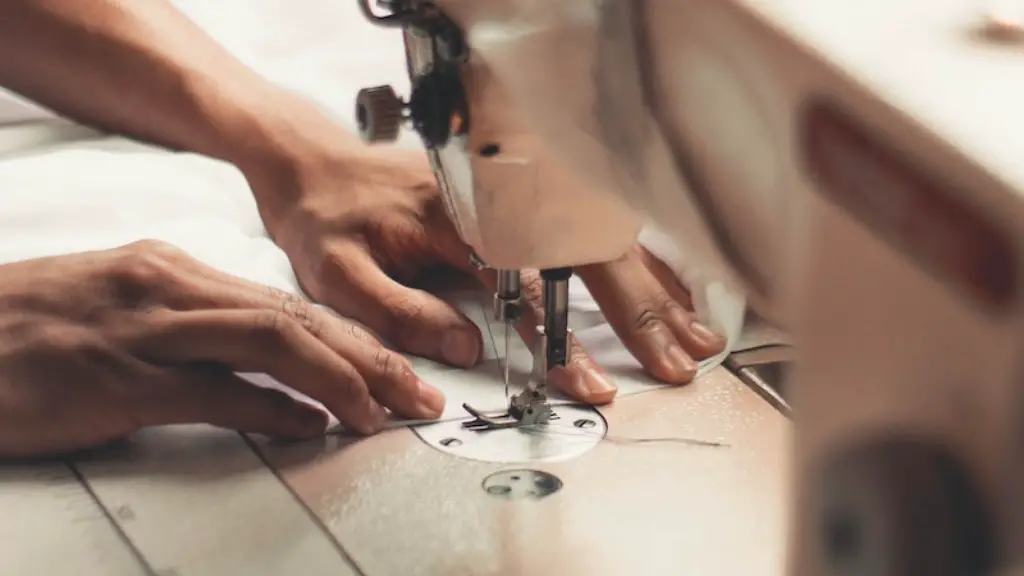As anyone who has ever sewn knows, there is no one-size-fits-all answer when it comes to the type of fabric you can sew. Different fabrics require different settings, stitches, and needles to make the perfect garment. When it comes to sewing denim, you may find yourself wondering if a regular sewing machine can handle the task.
To answer this question, it is important to understand some basics about denim and the fabrics it is made from. Denim is a heavy-weight, twill textile that is usually composed of cotton, and sometimes mixed with other fibers such as linen and wool. The fibres are woven together in a process that creates diagonal ribs in the fabric, strengthening the fabrics natural weave and making it more durable. Denim is a very hard wearing fabric that is ideal for jeans and jackets.
The durability of denim is why it can be tricky to sew with a regular sewing machine. Regular sewing machines are not designed with the power or the heavy industrial needles required to handle heavier materials. This means that if your machine is not specifically designed for handling heavy-duty materials like denim, it is likely to get damaged when sewing with it. Additionally, the high stiffness of denim fabrics can also make it difficult to use a regular sewing machine.
Different Machine Settings
Fortunately, there are settings on some regular sewing machines that allow you to use heavier fabrics like denim. Look for a setting labelled as ‘denim’ or ‘heavy-duty’ and adjust the tension, stitch length and thread size accordingly. Depending on the machine, you may need to install heavier-gauge needles, such as a 90/14, as well as a heavier-weight walking foot to help you sew through the layers of thick fabric. Make sure to use heavy-duty threads as well, such as polyester or nylon.
It is also a good idea to make a muslin sample out of your fabric before starting your project. This way, you can test your stitches and tension settings, and make sure that the machine can handle the denim fabric.
If you are using a regular sewing machine for denim, you want to make sure that you are using the correct needle and thread. Generally, smaller size needles work best for denim. It is also a good idea to double up the thread so that the stitches are more secure.
Overlockers and Industrial Machines
Using a regular seamstress machine can be time-consuming and difficult when it comes to dealing with heavier materials like denim. To make things easier and quicker, you might want to invest in a serger or an overlocker. These machines are specifically designed to handle heavier fabrics like denim with ease. The overlocker has blades that are able to cut through the fabric while stitching, while the serger has specialized needles and stitch settings ideal for sewing heavier fabrics.
If you plan on working with denim regularly, it might be worthwhile to invest in a heavy-duty industrial machine. Industrial machines are specifically designed for dealing with thick, heavy fabrics. They have stronger motors and feed-dogs to cope with heavier materials and long-arm sewing capabilities. Industrial sewing machines are available for home use, but be prepared to pay a premium for them.
Sewing Tips for Denim
Regardless of what machine you use, there are a few things you can do to make sewing denim easier and more successful. Use small, even stitches and consider back-stitching at the start and end of each seam. Use large pins and always use the right side of the needle when piercing the fabric. If your machine has an adjustable presser foot, use it to help you feed the fabric through the machine. If not, try pressing the fabric down with your fingers while you sew.
Denim can also be tricky to press, as the fibres are so dense. Use a heavy-duty pressing cloth and a hot iron to press your seams and prevent the fabric from shrinking. You can also spray the fabric with water as you press, to help it lay flat.
Using Topstitch and High-Shank Needles
Another useful tool for dealing with denim is a topstitch needle. These needles have a larger eye and a larger shaft, allowing them to carry heavier threads. The big eye also makes it easier to thread, meaning less frustration and fewer breaks in the thread.
Using a high-shank needle is also recommended when sewing denim. A high-shank needle is a heavier duty needle that is designed to penetrate thicker fabrics. An industrial machine will come with a standard high-shank needle, but you can purchase one separately if you’re using a regular sewing machine.
Rotary and Cutters
Although scissors are often the tool of choice for cutting fabric, they can be difficult to use when cutting denim. For this reason, many sewers prefer to use rotary cutters and mats to cut the fabric. This is faster, more efficient, and more accurate. However, make sure you use the right cutting mat and rotary blades for the job.
When cutting denim, mark your lines with a fabric chalk and cut one layer at a time. Cut slowly and carefully, and use your rotary cutter like a pair of scissors, moving it directly up and down or from side to side. Use a rotary blade specifically designed for heavy-duty fabrics, such as denim.
Conclusion
To summarise, a regular sewing machine can be used for sewing denim but it is not ideal. Heavier fabrics like denim require special settings, threads, needles and machines to make the perfect garment. It is best to use a machine specifically designed for heavy-duty materials or an industrial machine, as well as special needles and threads. Additionally, rotary cutters and mats are ideal for cutting denim, as they are more accurate and efficient than scissors.



